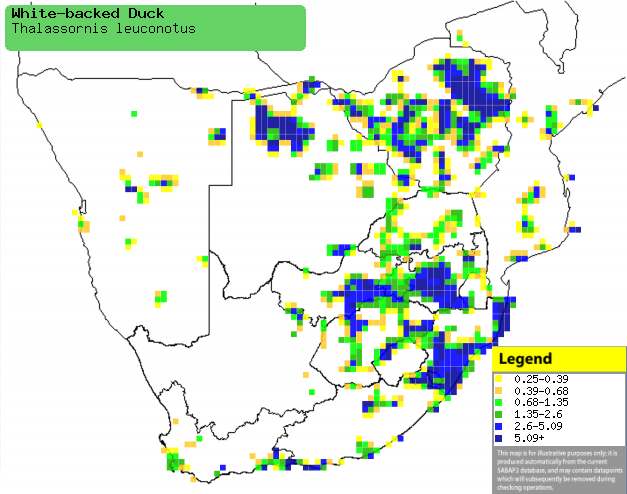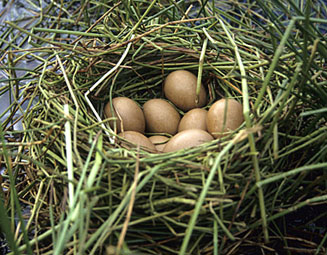|
Thalassornis leuconotus
(White-backed duck)
Witrugeend [Afrikaans]; Idada (generic term for duck)
[Xhosa]; Letata (generic term for duck) [South Sotho]; Dada, Sekwe (both are
generic names for duck or goose) [Shona]; Sekwa (generic term for duck or goose)
[Tsonga]; Witrugeend [Dutch]; Dendrocygne à dos blanc [French];
Weißrückenente [German]; Pato-de-dorso-branco [Portuguese]
Life
> Eukaryotes >
Opisthokonta
> Metazoa (animals) >
Bilateria >
Deuterostomia > Chordata >
Craniata > Vertebrata (vertebrates) > Gnathostomata (jawed
vertebrates) > Teleostomi (teleost fish) > Osteichthyes (bony fish) > Class:
Sarcopterygii (lobe-finned
fish) > Stegocephalia (terrestrial
vertebrates) > Tetrapoda
(four-legged vertebrates) > Reptiliomorpha > Amniota >
Reptilia (reptiles) >
Romeriida > Diapsida > Archosauromorpha > Archosauria >
Dinosauria
(dinosaurs) > Saurischia > Theropoda (bipedal predatory dinosaurs) >
Coelurosauria > Maniraptora > Aves
(birds) > Order: Anseriformes >
Family: Dendrocygnidae
A small diving duck with rufous and dark-brown barring,
a black bill and a diagnostic pale spot at the base of the bill, widely
distributed in sub-Saharan Africa on waterbodies with emergent and floating
plants. Feeds almost exclusively on seeds of aquatic plants, which it obtains
from the muddy bottom by diving.
Distribution and habitat
Distributed through sub-Saharan Africa but generally
absent from equatorial rainforest and desert regions. Prefers natural or
artificial water bodies that have clear water with emergent and floating
plants. Its main means of obtaining food is through diving for
aquatic plant seeds from the muddy bottom and it does so in waters ranging in
depth from 30-180 cm.
|
 |
|
Distribution of White-backed duck in southern Africa,
based on statistical smoothing of the records from first SA Bird Atlas
Project (©
Animal Demography unit, University of
Cape Town; smoothing by Birgit Erni and Francesca Little). Colours range
from dark blue (most common) through to yellow (least common).
See here for the latest distribution
from the SABAP2. |
Predators and parasites
- Predators
- Parasites
- Platyhelminthes (flatworms) > Trematoda (flukes)
- Trichobilharzia schoutedeni (recorded
from Rwanda)
- Pathogens
- Mycobacterium causing avian tuberculosis
(recorded in captivity)
Food
- Seeds of aquatic plants (about 97% of diet)
- Nymphaea nouchali (Blue water lily)
- Nymphoides indica (Small yellow water lily)
- Persecaria limbata (Knotweed)
- Echinochloa stagnina (Long-awned water
grass)
- Paspalidium geminatum (Swamp grass)
- Aeschynomene nodulosa (Knuckle-bean)
- Polygonum
- Vegetative parts of aquatic plants (about 3% of diet)
- Nymphaea nouchali (Blue water lily)
- Animal matter (small percentage of diet)
-
Diptera (flies) > Chironomidae (midge) larvae.
Breeding
- Nest is built by both sexes and is located in a
dense stand of reeds or rushes or grasses or sedges growing in the water.
The vegetation is bent over to form a vegetative base to the nest, with some
of the bases of the bent over stems forming a wall round the nest, broken in
one part by an access ramp leading to the water. The nest can be floating or
built up on the vegetation to as high as 45 cm above water level. It is
sometimes built on top of an old grebe
or Red-knobbed coot nest.
There is also vegetation overhanging the nest, which helps to obscure it
from above. The nest itself consists of a bowl of dead or living plant
material drawn in from around the site and padded with green aquatic grass.
 |
|
|
White-faced duck nest with eggs, Wakkerstroom,
South Africa. [photo
Warwick Tarboton ©] |
|
- Breeding season is year-round.
- The female lays a clutch of 4-9 eggs at a rate
of one per day (up to 11 eggs have been recorded in a clutch but this is
though to be due to egg dumping by other females). After the clutch has been
completed, both sexes incubate the eggs for 29-33 days before they
hatch. The female incubates at night and for about an hour in the middle of
the day, and the male incubates for the remainder of the day. Nest
changeover is communicated through an exchange of calls and a bird usually
approaches the nest underwater.
- Ducklings are able to swim, dive and feed within
20 hours of hatching. They are 50% of adult size by 27 days old; by 34 days
they have all their feathers except for some wing feathers, and by 55 days
they look exactly like the adult. The adults accompany the brood until at
least fully grown and are highly protective of them, using the 'broken wing
act' to draw predators away from the ducklings, the latter of which scatter
and hide when danger lurks.
Threats
Not considered under threat. However, noteworthy that
White-backed ducks disappeared from certain water bodies after the introduction
of Tilapia fishes, caused by the fishes destroying most of the aquatic
vegetation.
Links
References
-
Hockey PAR, Dean WRJ and Ryan PG (eds) 2005. Roberts
- Birds of southern Africa, VIIth ed. The Trustees of the John Voelcker
Bird Book Fund, Cape Town.
|
